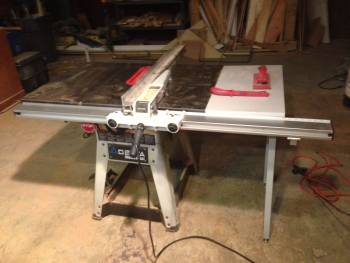This is an old revision of the document!
Delta 10" Table Saw
| Status | Operational |
|---|---|
| Zone | Woodshop |
| Owner | Carl Raymond |
| Tool Type | Table Saw |
| Member Category | Full |
| User Manual | deltatablesaw36978.pdf |
| Manufacturer | Delta |
| Model | 36-979 |
| SOPs | Link |
| Checkout Required | |
| |
|
Description
The table saw is a woodworking tool consisting of a circular saw blade, mounted on an arbor, that is driven by an electric motor. The blade protrudes through the surface of the table, which provides support for the material, usually wood, being cut. The depth of the cut is varied by moving the blade up and down: the higher the blade protrudes above the table, the deeper the cut that is made in the material. The angle of cut is controlled by adjusting the angle of blade.
Checkout/Training Procedures
- Contact Brian Adams or Carl Raymond for training.
Safety Rules
In addition to the shop safety rules the following should be observed while using the table saw.
- If the cutting operation is dusty, wear a dust mask.
- Do not wear gloves while operating a table saw.
- Avoid long sleeves, ties, dangling jewelry or any other loose fitting clothing while operating a table saw. The clothing could get caught in the blade.
- Use a push stick to cut narrow stock.
- Use a stop block when you crosscut short lengths.
- Position your body so that it is NOT in line with the blade. This is to avoid being injured by flying sawdust, woodchips or the work.
- The height of the blade should be set just slightly higher than the stock being cut. It should never be more than 6mm above the height of the stock. This is to ensure that if your hand slip you only receive a slight cut and do not lose a limb.
- Always stand firmly on the floor and avoid any awkward operations. This is to avoid falling into the blade by slipping or losing your balance.
- Do not carry on a conversation while cutting. Pay attention to the work being performed.
- Do not reach behind or over the blade unless it has stopped turning.
- Do not leave the saw until the blade has come to a complete stop.
- Always disconnect the power prior to changing the blade or performing any other maintenance operation.
- Make sure that the blade has stopped turning before you adjust the table saw.
- After any adjustment, make sure that the blade is free before you turn on the power.
- Ensure that the guides are positioned properly and that the tabletop is smooth and polished. An unclean or rough table requires you to use more force to push the stock through the blade. The more force that you are required to use the more chance that you may slip or lose your balance.
- Maintain the rip fence parallel to the blade so the stock will not bind on the blade and be thrown.
- Check the throat plate to ensure that it fits exactly and has a slot just slightly larger that the blade. Never operate a table saw with the throat plate removed
- Do not make free-hand cuts on the table saw. The stock must be guided through the blade either by the rip fence or the mitre gauge.
- Keep the blades' guards, spreaders and antikickback devices in place and operating properly. The spreader must be in alignment with the blade and the antikickback device must be in place and operating properly. Their action must be checked before cutting.
- Only seasoned, dry, flat wood should be cut.
- Work should be released only when it has gone past the blade.
- Whenever the stock is lifted or tilted above the surface of the table, the saw can shake the stock, causing you to lose your grip. Losing your grip on a piece means that your hand can slip toward the saw blade or the work can be forcefully kicked back towards you.
- Check that the stock has no nails, knots screw, stones etc. in it prior to cutting into the wood. These items can become projectiles and cause injury.
- Do not use the fence and a mitre gauge at the same time, unless they are both on the same side of the fence.
- The fence must not be adjusted while the saw is running.
- While long stock is sometimes crosscut on a table saw, it is not a good practice. The long stock may interfere with other operations and may be a hazard to other workers or equipment. It is also difficult to support and is better cut on a mitre saw or radial arm saw.
Safety Training
- Review of machine and shop safety rules.
- Proper procedures for setting up and performing a ripping operation
- Proper procedures for setting up and performing a crosscut operation
- Proper procedures for tool / blade changing operations
- Proper procedures for cleanup.
